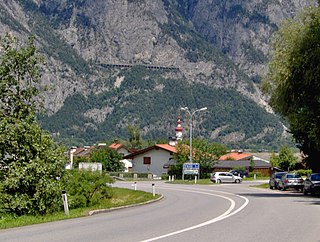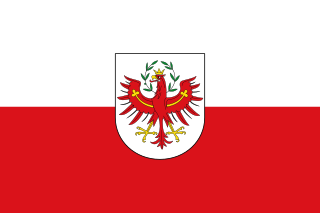
Hatting is a municipality in the district Innsbruck-Land and is located 18 km west of the city of Innsbruck. The village was mentioned around 11th century for the first time.

Oberperfuss is a municipality in the district of Innsbruck-Land in the Austrian state of Tyrol located about 15 km (9.3 mi) west of Innsbruck at the entrance of the Sellrain Valley. It was mentioned in documents around 1083 for the first time.

Ellbögen is a community in the district of Innsbruck Land and lies 12 km south of Innsbruck. It is a scattered village located on the eastern valley side of the Wipptal.

Kematen in Tirol is a municipality in the district Innsbruck-Land located about 12 km west of Innsbruck. The Melach river flows into the Inn river in Kematen. Kematen was first mentioned as „Caminata“ around 600.

Kolsass is a municipality in the district Innsbruck-Land in the Austrian state of Tyrol located about 17 km east of Innsbruck. The location was first mentioned as „Quolesazz or Cholsasz" in 1050.

Kolsassberg is a municipality in the district Innsbruck-Land in the Austrian state of Tyrol located about 19 km east of Innsbruck and 2 km above Kolsass. The location was founded around 1196.

Mutters is a municipality in the Innsbruck-Land district in the Austrian state of Tyrol. It is located 4.70 km (3 mi) south of Innsbruck. The village was first mentioned in 1100 but settlement already began app. 3000 years ago. Mutters received connection with Innsbruck thanks to the Stubaitalbahn in 1904.

Natters is a municipality in the district Innsbruck-Land in the Austrian state of Tyrol located 3.5 km south of Innsbruck. The village was mentioned in documents around 1151 for the first time. Natters as well as Mutters received connection with Innsbruck thanks to the Stubaitalbahn in 1904. It has 1918 inhabitants and an own hospital. The popular Natterer See is a treasure for tourists in summer.

Oberhofen im Inntal is a municipality in the western district of Innsbruck-Land in the Austrian state of Tyrol located 21 km west of Innsbruck and 2.6 km east of Telfs. Once a part of Pfaffenhofen it became an own municipality in 1786.

Pettnau is a municipality in the district of Innsbruck-Land in the Austrian state of Tyrol located 16.7 km west of Innsbruck north of the Inn River between Telfs and Zirl. It has seven parts and was founded around 1291.

Pfaffenhofen (help·info) is a municipality in the district of Innsbruck-Land in the Austrian state of Tyrol located 22 km west of Innsbruck and 1.7 km south of Telfs. The village was mentioned in documents in 1197 for the first time.

Zirl is a market town in the district of Innsbruck-Land in the Austrian state of Tyrol located 10 km west of Innsbruck at the bottom of a pass up the side of the Zirler Berg, leading to Seefeld and ultimately to Germany. The location was mentioned in documents in 799 for the first time. Zirl was damaged several times by floods and fires but nevertheless the population has increased in recent years. The status "Market town" was received in 1984.

Unterperfuss is a municipality in the district of Innsbruck-Land in the Austrian state of Tyrol located 15 km west of Innsbruck and is one of the smallest villages of Tyrol. The area is restricted in the north by the Inn River and in the east by the Melach River. Unterperfuss has many facilities for horse-riding.

Tulfes is a municipality in the district of Innsbruck-Land in the Austrian state of Tyrol, located 12 km east of Innsbruck and 6 km above Hall in Tirol. The village was mentioned as “Tellevo” for the first time in 1240. Main source of income is tourism. Tulfes became a popular area of settlement due to the cities of Innsbruck and Hall.

Sellrain is a municipality in the district of Innsbruck-Land in the Austrian state of Tyrol located 14.40 km southwest of Innsbruck in the Sellrain Valley. The Melach River and its tributary the Fotscherbach flow through it. Most people in the village are farmers and also have another job in the neighboring Innsbruck. There are two Catholic churches in the village St. Quirin and St. Anna. They are both over 300 years old.

Schönberg im Stubaital is a municipality in the district of Innsbruck-Land, Tyrol, Austria. It is 9 km (5.6 mi) south of Innsbruck at the entrance of the Stubaital. The village was mentioned as “Schönenberge” for the first time in 1180.

Reith bei Seefeld is a municipality in the district of Innsbruck-Land in the Austrian state of Tyrol located 12.3 km northwest of Innsbruck and 3 km south of Seefeld in Tirol. The village was founded in 1350. At that time stone oil (=petroleum) was found and is used for healing purposes until now.

Ranggen is a municipality in the district of Innsbruck-Land in the Austrian state of Tyrol located 12 km west of Innsbruck. The location was mentioned as “Fergen” in 1482 for the first time. Ranggen has 17 parts.

Polling in Tirol is a municipality in the district of Innsbruck-Land in the Austrian state of Tyrol located 17 km west of Innsbruck and 7 km before Telfs. The location was mentioned as “Pollinga” in 763 for the first time.

Mils is a municipality in the district Innsbruck-Land and is located 12 km east of Innsbruck. The area is restricted by the Weißenbach in the west and the Inn in the south. The location was mentioned in documents in 930 for the first time. In the last 40 years Mils grew enormous thanks to its sunny location.















